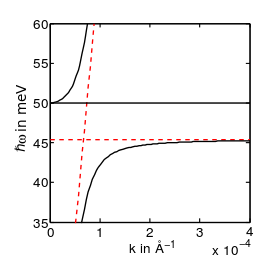Lyddane–Sachs–Teller relation
In condensed matter physics, the Lyddane–Sachs–Teller relation (or LST relation) determines the ratio of the natural frequency of longitudinal optic lattice vibrations (phonons) () of an ion crystal to the natural frequency of the transverse optical lattice vibration () for long wavelengths (zero wavevector).[1] The ratio is equal to the ratio of the static permittivity (Often also ) to the permittivity for frequencies in the visible range (often also ).[2]
The Lyddane–Sachs–Teller relation is named after the physicists R. H. Lyddane, Edward Teller, and R. G. Sachs.
Origin and limitations

The Lyddane–Sachs–Teller relation applies to optical lattice vibrations that have an associated net polarization density, so that they can produce long ranged electromagnetic fields (over ranges much longer than the inter-atom distances). The relation assumes an idealized polar ("infrared active") optical lattice vibration that gives a contribution to the frequency-dependent permittivity described by a lossless Lorentzian oscillator:
where is the permittivity at high frequencies, is the static polarizability of the optical lattice mode, and is the "natural" oscillation frequency of the lattice vibration taking into account only the short-ranged (microscopic) restoring forces. The above equation can be plugged into Maxwell's equations to find the complete set of normal modes including all restoring forces (short-ranged and long-ranged), which are sometimes called phonon polaritons. In Maxwell's equations, an electric longitudinal wave occurs when the permittivity passes through zero, i.e.
- .
For the Lorentzian resonance described above, this longitudinal mode frequency is given by the Lyddane–Sachs–Teller relation.[3] A transverse resonance at is also present although it does not extend all the way to k=0 since for small, lightlike wavevectors, the magnetic fields generated by the transverse polarization currents cannot be neglected and lead to hybridizing of the lattice vibration with light (see figure).
Since the Lyddane–Sachs–Teller relation is derived from the lossless Lorentzian oscillator, it may break down in realistic materials where the permittivity function is more complicated for various reasons:
- Real phonons have losses (also known as damping or dissipation).
- Materials may have multiple phonon resonances that add together to produce the permittivity.
- There may be other electrically active degrees of freedom (notably, mobile electrons) and non-Lorentzian oscillators.
In the case of multiple, lossy Lorentzian oscillators, there are generalized Lyddane–Sachs–Teller relations available.[4] Most generally, the permittivity cannot be described as a combination of Lorentizan oscillators, and the longitudinal mode frequency can only be found as a complex zero in the permittivity function.[4]
References
- ↑ Lyddane, R.; Sachs, R.; Teller, E. "On the Polar Vibrations of Alkali Halides". Physical Review. 59 (8): 673–676. Bibcode:1941PhRv...59..673L. doi:10.1103/PhysRev.59.673.
- ↑ Laurence Charles, Robinson: The Lyddane-Sachs-Teller-relationship
- ↑ Ashcroft, Neil W.; Mermin, N. David (1976). Solid State Physics. Holt, Rinehart and Winston. ISBN 0-03-083993-9.
- 1 2 Chang, I. F.; Mitra, S. S.; Plendl, J. N.; Mansur, L. C. (1968). "Long-Wavelength Longitudinal Phonons of Multi-Mode Crystals". Physica Status Solidi (b). 28 (2): 663–673. Bibcode:1968PSSBR..28..663C. doi:10.1002/pssb.19680280224.